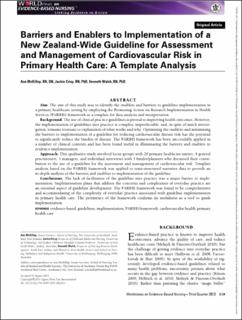| dc.contributor.author | McKillop, A. | |
| dc.contributor.author | Crisp, J. | |
| dc.contributor.author | Walsh, K. | |
| dc.date.accessioned | 2023-01-09T09:26:30Z | |
| dc.date.available | 2023-01-09T09:26:30Z | |
| dc.date.issued | 2012 | |
| dc.identifier.citation | McKillop, A., Crisp, J. & Walsh, K. (2012). Barriers and Enablers to Implementation of a New Zealand‐Wide Guideline for Assessment and Management of Cardiovascular Risk in Primary Health Care: A Template Analysis. Worldviews on Evidence‐Based Nursing, 9(3), 159–171. | en_US |
| dc.identifier.uri | https://hdl.handle.net/11250/3041819 | |
| dc.description.abstract | Aim: The aim of this study was to identify the enablers and barriers to guideline implementation in a primary healthcare setting by employing the Promoting Action on Research Implementation in Health Services (PARIHS) framework as a template for data analysis and interpretation.
Background: The use of clinical practice guidelines is pivotal to improving health outcomes. However, the implementation of guidelines into practice is complex, unpredictable, and, in spite of much investigation, remains resistant to explanation of what works and why. Optimising the enablers and minimising the barriers to implementation of a guideline for reducing cardiovascular disease risk has the potential to significantly reduce the burden of disease. The PARIHS framework has been successfully applied in a number of clinical contexts and has been found useful in illuminating the barriers and enablers to evidence implementation.
Approach: This qualitative study involved focus groups with 20 primary healthcare nurses, 4 general practitioners, 5 managers, and individual interviews with 3 funder/planners who discussed their contribution to the use of a guideline for the assessment and management of cardiovascular risk. Template analysis based on the PARIHS framework was applied to semi-structured narrative data to provide an in-depth analysis of the barriers and enablers to implementation of the guideline.
Conclusions: The lack of facilitation of the guideline into practice was a major barrier to implementation. Implementation plans that address the concerns and complexities of everyday practice are an essential aspect of guideline development. The PARIHS framework was found to be comprehensive and accommodating of the complexity of everyday practice associated with guideline implementation in primary health care. The pertinence of the framework confirms its usefulness as a tool to guide implementation. | en_US |
| dc.publisher | Worldviews on Evidence‐Based Nursing | en_US |
| dc.subject | evidence-based | en_US |
| dc.subject | guidelines | en_US |
| dc.subject | implementation | en_US |
| dc.subject | PARIHS framework | en_US |
| dc.subject | cardiovascular health | en_US |
| dc.subject | primary health care | en_US |
| dc.title | Barriers and Enablers to Implementation of a New Zealand‐Wide Guideline for Assessment and Management of Cardiovascular Risk in Primary Health Care: A Template Analysis | en_US |
| dc.type | Journal article | en_US |
| dc.source.pagenumber | 159–171 | en_US |
| dc.source.volume | 9 | en_US |
| dc.source.journal | Worldviews on Evidence‐Based Nursing | en_US |
| dc.source.issue | 3 | en_US |
| dc.identifier.doi | https://doi.org/10.1111/j.1741-6787.2011.00233.x | |
